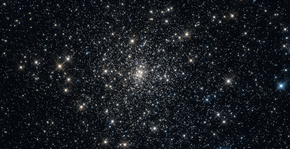| NGC 6256 | |
|---|---|
 NGC 6256 as seen through the
Hubble Space Telescope | |
| Observation data ( J2000 epoch) | |
| Constellation | Scorpius |
| Right ascension | 16h 59m 32.68s [1] |
| Declination | −37° 07′ 17.1″ [1] |
| Distance | 22 kly (6.8 kpc) [2] |
| Apparent magnitude (V) | 11.3 [3] |
| Apparent dimensions (V) | 7′ [4] |
| Physical characteristics | |
| Absolute magnitude | −7.15[ citation needed] |
| Estimated age | 13.0±0.5 Gyr [2] |
| Other designations | NGC 6256, GCL 49.1, ESO 391-SC6 and vdB-Hagen 208 [5] |
NGC 6256 is a globular cluster of stars in the southern constellation of Scorpius. It was discovered by the Scottish astronomer James Dunlop on Aug 2, 1826. [6] In J. L. E. Dreyer's New General Catalogue annotation it is described as, "very faint, very large, very gradually bright in the middle, well resolved clearly consisting of stars." [7] The cluster is located at a distance of 22 thousand light-years (6.8 kpc) from the Sun. [2]
This is an ancient cluster with an estimated age of about 13 billion years; it was formed during the very early stages of assembly of the Milky Way galaxy. The cluster is orbiting within the galactic bulge with a low orbital eccentricity. It is heavily reddened by extinction due to interstellar gas and dust. [2] The structure is very concentrated at the center, showing a post core collapse morphology. [8]
The HR diagram for this cluster displays two sequences of blue straggler stars, which are the products of stellar mergers. The bluer sequence is well-defined and narrow, most likely being generated over a short time span. The redder sequence is more sparse, being the result of a continuous process of formation. It is hypothesized that the bluer sequence was formed around the time of the cluster's core collapse about one billion years ago; an event that made stellar collisions more likely. [9]
The cluster contains a millisecond X-ray pulsar, designated IGR J16597-3704. [10]
References
- ^ a b Di Criscienzo, M.; et al. (February 2006). "RR Lyrae-based calibration of the Globular Cluster Luminosity Function". Monthly Notices of the Royal Astronomical Society. 365 (4): 1357–1366. arXiv: astro-ph/0511128. Bibcode: 2006MNRAS.365.1357D. doi: 10.1111/j.1365-2966.2005.09819.x. S2CID 17838243.
- ^ a b c d Cadelano, M.; et al. (May 2020). "Digging for Relics of the Past: The Ancient and Obscured Bulge Globular Cluster NGC 6256". The Astrophysical Journal. 895 (1). id.54. arXiv: 2004.06131. Bibcode: 2020ApJ...895...54C. doi: 10.3847/1538-4357/ab88b3.
- ^ O'Meara, Stephen James (2013). Deep-Sky Companions: Southern Gems. Cambridge University Press. p. 331. ISBN 9781107015012.
- ^ Frommert, Hartmut. "NGC 6256". Students for the Exploration and Development of Space. Retrieved 2024-05-23.
- ^ "NGC 6256". SIMBAD. Centre de données astronomiques de Strasbourg. Retrieved 2024-05-23.
- ^ Seligman, Courtney. "NGC Objects: NGC 6250 - 6299". Celestial Atlas. Retrieved 2024-05-23.
- ^ Terzan, A.; Lelievre, G. (December 1973). "The Cluster NGC 6256". Astronomy and Astrophysics. 29: 431. Bibcode: 1973A&A....29..431T.
- ^ Ortolani, S.; et al. (April 1999). "Colour-magnitude diagrams of the post-core collapse globular clusters NGC 6256 and NGC 6717 (Palomar 9)". Astronomy and Astrophysics Supplement. 136 (2): 237–243. Bibcode: 1999A&AS..136..237O. doi: 10.1051/aas:1999210.
- ^ Cadelano, Mario; et al. (December 2022). "Discovery of a Double Sequence of Blue Straggler Stars in the Core-collapsed Globular Cluster NGC 6256". The Astrophysical Journal. 941 (1). id. 69. arXiv: 2211.02671. Bibcode: 2022ApJ...941...69C. doi: 10.3847/1538-4357/aca016.
- ^ Tetarenko, A. J.; et al. (February 2018). "A Radio Frequency Study of the Accreting Millisecond X-ray Pulsar, IGR J16597-3704, in the Globular Cluster NGC 6256". The Astrophysical Journal. 854 (2). id. 125. arXiv: 1801.05778. Bibcode: 2018ApJ...854..125T. doi: 10.3847/1538-4357/aaa95a.
External links
-
 Media related to
NGC 6256 at Wikimedia Commons
Media related to
NGC 6256 at Wikimedia Commons